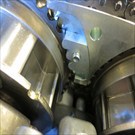Chevrolet Cruze 1.4L LUV Timing Tools
Posted to Tool & Equipment Forum on 5/15/2013
24 Replies
This post will provide a little visual insight and some tool
information related to various service procedures on the
engine camshaft and timing system on Chevrolet Cruze 1.4L
turbo RPO LUV) engines. Whether working on a Cruze LUV or a
Volt LUU, the same tools are required.
Whenever various procedures are performed, from camshaft
phasers, timing components, camshaft replacement etc.,
precision alignment of the timing components is necessary.
On this particular engine family, there are more tools
required than on some earlier engines, which appear to be
similar.
There is no provision for "guess and by golly" techniques of
"yesteryear" to be the option when servicing these and many
other modern engines. During a procedure, I had my camera
handy and thought it worthy to share the photos of the main
tools in use as a visual aid. Some tools referenced here are
not shown, but are necessary for all of the timing
components to be precisely positioned.
Note that when the camshaft bolts are loosened, they must be
replaced, since they are Torque To Yield (TTY). Hold the
camshafts with a wrench on the hex behind the camshaft
phasers while removing or torquing the bolts.
Not shown is the crankshaft fixing tool EN-952 (KM-952). It
is installed at the lower front of the crankcase, to engage
in an alignment hold in the crankshaft, once a plug is
removed from the cylinder block. The tool should not be
forced or bind in the hole when the crankshaft is correctly
position. While it is not shown, this is an important step,
not to be omitted. Just as important, is to remember to
remove the holding tool and reinstall the plug when the
procedure is complete. If you think that you might forget
this step, put a Post It note on the driver's door or
steering wheel as a reminder!
[2012 Chevrolet Cruze LT, Engine/Propulsion Photo]
shows the camshafts held in correct position, similar to
other engines with slots at the rear of the camshafts. It
may be necessary to use a wrench on the camshafts to engage
the tool fully into the slots.
Since the engine has camshaft phasers, tools are required to
ensure that the phasers are correctly positioned relative to
the camshafts. This is accomplished by installation of a
holding tool to the intake cam phaser sprocket. [2012
Chevrolet Cruze LT, Engine/Propulsion Photo] shows the
tool as installed in the front view and [2012 Chevrolet
Cruze LT, Engine/Propulsion Photo] show the installation
rear view.
As mentioned, the camshaft bolts which also serve as the
hollow hydraulic camshaft phaser control valves, are TTY.
[2012 Chevrolet Cruze LT, Engine/Propulsion Photo] shows
the intake camshaft solenoid removed exposing the bolt. This
bolt secures the camshaft, phaser and exciter ring together.
Hold the camshafts with a wrench whenever loosening or
tightening and torquing this bolt. The tools are intended
for alignment of the timing components, not holding tools
for removal and torquing of tight fasteners.
Locking pins EN-955 (KM-955) are used during chain and
phaser procedures to maintain chain tension, but not shown
in photos here.
Since the camshaft exciter rings camshaft phasers and
camshafts have no dowels or tangs to maintain alignment,
once installed they rely on a consistent clamping load of
the new TTY camshaft bolt, to hold them securely in
alignment. Shown in [2012 Chevrolet Cruze LT,
Engine/Propulsion Photo] is the exciter ring positioning
tool. The tool engages in slots in the intake and exhaust
camshaft exciter rings and again, the tool is not used to
hold components while loosening or torquing the camshaft
bolts. [2012 Chevrolet Cruze LT, Photo] shows the slot
in the intake cam exciter ring.
Without going into lengthy details of the various procedures
associated with the need for the tools depicted in the
photos above, it is essential that the set up steps of the
procedures be followed in the correct order to accurately
time the involved components. The tools are available
through Kent Moore and where applicable the EN (Engine) and
KM # or other is shown.
Note that the camshaft cover gasket is rubber and fits into
a groove similar to many other engines. It should be
replaced not re-used when the cover is removed.
Regards,
Martin from British Columbia
 24 Replies Received
(View Replies)
24 Replies Received
(View Replies)
 24 Replies Received
(Hide Replies)
24 Replies Received
(Hide Replies)
|







 24 Replies Received
24 Replies Received
 24 Replies Received
24 Replies Received